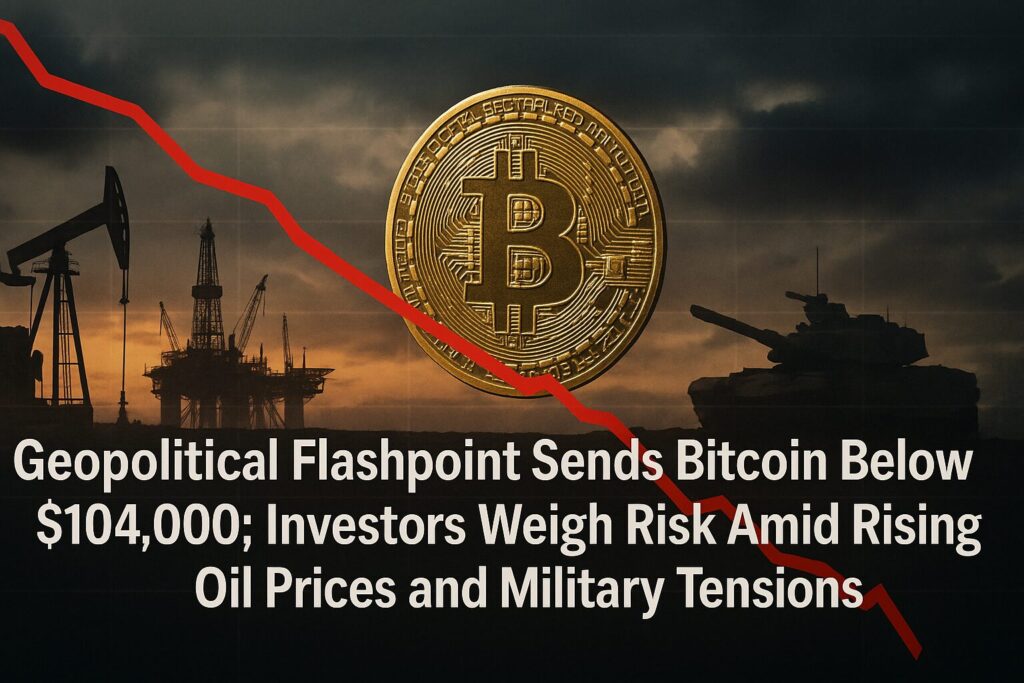
Main Points:
- Bitcoin plunged 3.8% to under $104,000 amid fears of U.S. military engagement in the Iran–Israel conflict.
- Broader crypto market, including Ethereum and Solana, saw steep losses; CoinDesk 20 Index fell 6.1%.
- Trump’s call for Iran’s “unconditional surrender” and evacuation warning escalated geopolitical risk premium.
- Oil prices surged over 4%—Brent crude above $76 and WTI near $75—on supply disruption concerns via Strait of Hormuz.
- Predictive markets now assign a 65% probability of U.S. military action against Iran by July.
- Analysts warn sustained tensions could spur inflation via oil price spikes, prompting Fed policy dilemmas.
1. Market Reaction: Bitcoin and Altcoins Under Pressure
In the 24 hours since President Trump’s public ultimatum to Iran, Bitcoin (BTC) has tumbled 3.8%, slipping back below $104,000 and marking its sharpest single-day drop in over a week. This decline mirrors a broader risk-off sentiment across the digital asset spectrum. The CoinDesk 20 Index—excluding stablecoins, exchange tokens, and meme coins—plunged 6.1%, with Ethereum (ETH) and Solana (SOL) each off by roughly 7%, and SUI down nearly 10% amid frantic liquidation.
Crypto equities have not been spared: major listed miners such as Bitdeer, Riot Platforms, CleanSpark, and Hut 8 saw share prices drop between 6% and 7%, while consumer-facing firms like Coinbase and Circle slid 2–3%. The synchronized sell-off underscores how geopolitical shocks can swiftly cascade through both token and equity markets, erasing recent gains made in June.
2. Geopolitical Context: Trump’s Ultimatum and Rising Tensions
On June 17, 2025, President Trump broke away early from the G7 summit to focus on Middle East developments, publicly demanding that Iran unconditionally surrender and urging Tehran residents to evacuate. In a social media post targeting Iran’s Supreme Leader Ayatollah Ali Khamenei, he asserted U.S. air supremacy and threatened unspecified military measures if civilian or American lives were jeopardized.
Polymarket, a leading prediction platform, saw the probability of U.S. military action against Iran jump to 65% for execution by July, up sharply from just 40% two days prior. Such market-based indicators highlight investor anxiety over a rapid escalation, with the Strait of Hormuz—a conduit for nearly 20% of global seaborne oil—at the epicenter of supply disruption fears.
3. Oil Market Dynamics and Economic Spillovers
Escalating hostilities have reignited concerns over oil supply, particularly from Iran, OPEC’s third-largest producer at 3.3 million barrels per day. On June 18, Brent crude climbed to $76.64 a barrel, while U.S. West Texas Intermediate (WTI) hit $75.07, up over 4% intraday as traders priced in potential outages near the Strait of Hormuz.
Analysts at Finequia warn that any prolonged disruption of Iranian output could fuel a fresh inflationary wave by driving energy costs higher, compounding consumer price pressures already elevated in the U.S.. Coupled with an upcoming Federal Reserve policy meeting—where rate cuts were debated—the confluence of rising commodity prices and geopolitical risk introduces novel challenges for central bankers.
4. Crypto-Specific Impacts: From Miners to Institutional Flows
Mining-focused equities have borne the brunt of the sell-off, with equipment-heavy firms like CleanSpark and Hut 8 down roughly 7% as margin pressures intensify amid lower BTC prices and higher energy costs. On-chain data from Glassnode indicates a slight uptick in miner coin flows to exchanges, signaling potential selling pressure to cover operational expenses.
Institutional investors are also recalibrating exposures. Grayscale’s Bitcoin Trust (GBTC) saw a modest expansion of its discount to NAV, reflecting waning demand under risk-off conditions. Meanwhile, stablecoin minting has plateaued, suggesting liquidity is no longer aggressively rotating into perceived safe-haven crypto assets.
5. Analyst Perspectives: Navigating Uncertainty
Javier Rodriguez-Alarcon, CIO at XBTO, emphasizes that without clear signs of de-escalation, risk assets will remain under pressure: “The geopolitical situation remains an outstanding variable. A meaningful détente in the Middle East could catalyze a rally, but further deterioration would likely trigger another broad-based sell-off”.
Matteo Greco, Senior Analyst at Finequia, warns of second-order effects: “Should Israel’s actions constrain Iran’s oil output, commodity price inflation could surge, forcing the Fed to delay rate cuts or consider tightening,” potentially undermining both equity and crypto valuations.
6. Broader Economic Implications and Fed Policy Outlook
Against this backdrop, global bond yields have dipped slightly as investors seek safer fixed income amidst equity and commodity volatility. Currency markets have reflected risk aversion too: the Indian rupee briefly slumped to a two-month low of 86.28 per U.S. dollar before partial recovery, underscoring sensitivity of emerging market currencies to commodity shocks.
At the Federal Reserve’s June meeting, most economists anticipate rates to hold steady; however, failure to address surging energy costs and geopolitical uncertainty could postpone anticipated rate cuts until later in the year.
7. Practical Takeaways for Crypto Investors
- Risk Management: In volatile geopolitical climates, consider tightening stop-loss orders and re-evaluating leverage positions to guard against sudden drawdowns.
- Diversification: Allocate a portion of crypto portfolios to stablecoins or less-volatile assets during peak uncertainty to preserve capital.
- On-Chain Signals: Monitor miner outflows and exchange inflows as leading indicators of selling pressure.
- Macro Hedging: Explore commodity-linked derivatives—such as oil futures or ETFs—as potential hedges against energy-driven inflation.
- Stay Informed: Follow reliable geopolitical and economic news sources; events in the Middle East can rapidly shift market sentiment.
Conclusion
The intersection of U.S. foreign policy, Middle East tensions, and macroeconomic drivers has introduced significant volatility into both cryptocurrency and traditional financial markets. Bitcoin’s drop below $104,000 highlights crypto’s susceptibility to geopolitical shocks, even as long-term adoption trends remain intact. For investors focused on new digital assets and revenue opportunities, disciplined risk management and close tracking of on-chain and macro indicators are paramount. As the U.S. Federal Reserve navigates competing pressures of inflation and growth, market participants should prepare for continued volatility and be ready to capitalize on clear signs of de-escalation or renewed risk appetite.

